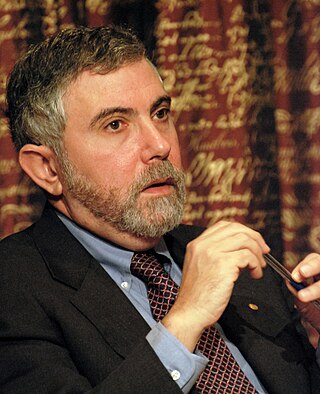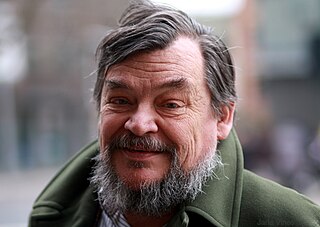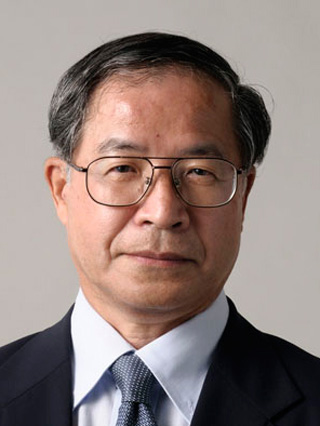
Economic growth can be defined as the increase or improvement in the inflation-adjusted market value of the goods and services produced by an economy in a financial year. Statisticians conventionally measure such growth as the percent rate of increase in the real and nominal gross domestic product (GDP).
Development economics is a branch of economics that deals with economic aspects of the development process in low- and middle- income countries. Its focus is not only on methods of promoting economic development, economic growth and structural change but also on improving the potential for the mass of the population, for example, through health, education and workplace conditions, whether through public or private channels.

Paul Robin Krugman is an American economist who is the Distinguished Professor of Economics at the Graduate Center of the City University of New York and a columnist for The New York Times. In 2008, Krugman was the winner of the Nobel Memorial Prize in Economic Sciences for his contributions to New Trade Theory and New Economic Geography. The Prize Committee cited Krugman's work explaining the patterns of international trade and the geographic distribution of economic activity, by examining the effects of economies of scale and of consumer preferences for diverse goods and services.

Endogenous growth theory holds that economic growth is primarily the result of endogenous and not external forces. Endogenous growth theory holds that investment in human capital, innovation, and knowledge are significant contributors to economic growth. The theory also focuses on positive externalities and spillover effects of a knowledge-based economy which will lead to economic development. The endogenous growth theory primarily holds that the long run growth rate of an economy depends on policy measures. For example, subsidies for research and development or education increase the growth rate in some endogenous growth models by increasing the incentive for innovation.

State ownership, also called public ownership or government ownership, is the ownership of an industry, asset, or enterprise by the state or a public body representing a community, as opposed to an individual or private party. Public ownership specifically refers to industries selling goods and services to consumers and differs from public goods and government services financed out of a government's general budget. Public ownership can take place at the national, regional, local, or municipal levels of government; or can refer to non-governmental public ownership vested in autonomous public enterprises. Public ownership is one of the three major forms of property ownership, differentiated from private, collective/cooperative, and common ownership.

Erik Steenfeldt Reinert is a Norwegian economist, with development economics, economic history and history of economic policy as his specialties.
The Rostovian take-off model is one of the major historical models of economic growth. It was developed by W. W. Rostow. The model postulates that economic modernization occurs in five basic stages, of varying length.
- Traditional society
- Preconditions for take-off
- Take-off
- Drive to maturity
- Age of High mass consumption

Sir James Alexander Mirrlees was a British economist and winner of the 1996 Nobel Memorial Prize in Economic Sciences. He was knighted in the 1997 Birthday Honours.
The legal origins theory claims that the two main legal traditions or origins, civil law and common law, crucially shape lawmaking and dispute adjudication and have not been reformed after the initial exogenous transplantation by Europeans. Therefore, they affect economic outcomes to date. According to the evidence reported by the initial proponents of such a theory, countries that received civil law would display today less secure investor rights, stricter regulation, and more inefficient governments and courts than those that inherited common law. These differences would reflect both a stronger historical emphasis of common law on private ordering and the higher adaptability of judge-made law.

Andrei Shleifer is a Russian-American economist and Professor of Economics at Harvard University, where he has taught since 1991. Shleifer was awarded the biennial John Bates Clark Medal in 1999 for his seminal works in three fields: corporate finance, the economics of financial markets, and the economics of transition.

Masahisa Fujita is a Japanese economist who has studied regional science and Urban economics and International Trade, Spatial Economy. He is a professor at Konan University and an adjunct professor at Institute of Economic Research, Kyoto University.

The Quarterly Journal of Economics is a peer-reviewed academic journal published by the Oxford University Press for the Harvard University Department of Economics. Its current editors-in-chief are Robert J. Barro, Lawrence F. Katz, Nathan Nunn, Andrei Shleifer, and Stefanie Stantcheva.

Development theory is a collection of theories about how desirable change in society is best achieved. Such theories draw on a variety of social science disciplines and approaches. In this article, multiple theories are discussed, as are recent developments with regard to these theories. Depending on which theory that is being looked at, there are different explanations to the process of development and their inequalities.
Ragnar Wilhelm Nurkse was an Estonian-American economist and policy maker mainly in the fields of international finance and economic development. He is considered the pioneer of Balanced Growth Theory.
Paul Narcyz Rosenstein-Rodan (1902–1985) was an economist of Jewish origin born in Kraków, who was trained in the Austrian tradition under Hans Mayer in Vienna. His early contributions to economics were in pure economic theory – on marginal utility, complementarity, hierarchical structures of wants and the pervasive Austrian School issue of time.
The Journal of Political Economy is a monthly peer-reviewed academic journal published by the University of Chicago Press. Established by James Laurence Laughlin in 1892, it covers both theoretical and empirical economics. In the past, the journal published quarterly from its introduction through 1905, ten issues per volume from 1906 through 1921, and bimonthly from 1922 through 2019. The editor-in-chief is Magne Mogstad.
The Other Canon Foundation is a center and network for research of heterodox economics founded by Erik Reinert. The name refers to the founders' message of there being another economic canon, alternative to the ruling neoclassical economics. Their suggestions, they claim, are valid for and can be applicated in the first, second and third world.
Ronald Edsel Findlay was an economist and trade theorist. He served as the Ragnar Nurkse Professor of Economics at Columbia University.
The balanced growth theory is an economic theory pioneered by the economist Ragnar Nurkse (1907–1959). The theory hypothesises that the government of any underdeveloped country needs to make large investments in a number of industries simultaneously. This will enlarge the market size, increase productivity, and provide an incentive for the private sector to invest.
The Strategy of Economic Development is a 1958 book on economic development by Albert O. Hirschman. Hirschman critiques the theories of balanced growth put forward by Ragnar Nurkse and Paul Rosenstein-Rodan, which call for simultaneous, large-scale increases in investment across multiple sectors to spur economic growth. Hirschman argues that such strategies are unrealistic and often infeasible in underdeveloped countries. In place of balanced growth, Hirschman proposes a theory of unbalanced growth, where "imbalances" and "pressure points" created by the growth process can be used to identify areas where policymakers can intervene. In addition, Hirschman introduces the notions of backward linkages---the demand created by a new industry for intermediate goods---and forward ones---the knock-on effects on industries who use the present industry's goods as inputs.









